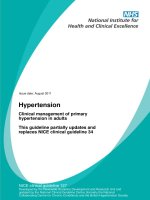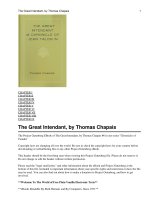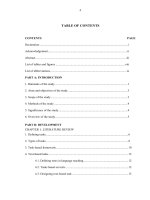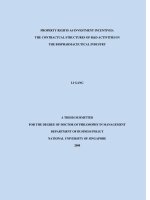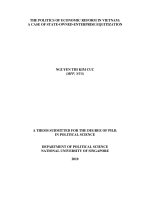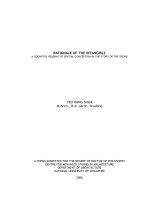The education assessment capacity structure of primary teachers in vietnam
Bạn đang xem bản rút gọn của tài liệu. Xem và tải ngay bản đầy đủ của tài liệu tại đây (264.85 KB, 12 trang )
VNU Journal of Science: Education Research, Vol. 34, No. 4 (2018) 1-12
The Education Assessment Competence Structure
of Primary Teachers in Vietnam
Nguyen Cong Khanh1,*, Do Thi Huong2
1
Hanoi National University of Education, No 136, Xuan Thuy street, Cau Giay district, Hanoi, Vietnam
2
Hanoi National University of Education-At Branch in Hanam Province, Ly Thuong Kiet Street,
Le Hong Phong sub-district, Phu Ly city, Ha Nam Province, Vietnam
Received 08 October 2018
Revised 05 November 2018; Accepted 07 November 2018
Abstract: Education assessment is considered to be indispensable competence for teachers at all levels.
However, there are currently many difficulties in assessing this competence, especially for primary
teachers when there is a change in assessing students. In this report, we would like to suggest an
education assessment competence structure for primary teachers and to demonstrate such structure
through a survey of primary teachers' assessment competences in Vietnam. Survey results have shown
that the education assessment competence structure consists of 6 component competencies which
suitable for primary teachers in Vietnam. And, the report also points out that Vietnamese primary
teachers' education assessment competences in Vietnam is currently evaluated.
Keywords: Education assessment competence, education assessment competence structure,
primary teachers.
1. Introduction
to be the most important step in the teaching
process because it helps to adjust the whole
teaching process of teaching, and to motivate
learners and help them to make ceaseless
progress [2, 3]. It is necessary for teachers to
have the education assessment competence
[4-6].
In scientific literature, the concept
“competence” is defined as a system of internal
mental structures and abilities assuming
mobilization of knowledge, cognitive skills,
practical skills, and also social and behavioural
components such as attitudes, emotions, values
and ethics, motivations for successful
realization of activity in a particular context
[7-9]. Competences are structured as sets of
knowledge, skills and and attitudes acquired
It is the strong explosion of information
technology and communication that has created
new communication means and expanded
learning opportunities for each individual.
School-based teaching is no longer the only
main source of information, so general
education renovation is considered as an
inevitable trend. When general education is
renovated, there are also changes in the role of a
teacher who wants to spend his whole life in
practicing as a teacher [1]. Assessment is said
_______
Corresponding author. Tel.: 84-904218270.
Email:
/>
1
2
N.C. Khanh, D.T. Huong / VNU Journal of Science: Education Research, Vol. 34, No. 4 (2018) 1-12
through learning; they allow identifying and
solving, in a variety of contexts, problems that
are characteristic for a specific domain of
knowledge and field of activity [8-10].
In the annex the Council Recommendation
on Key Competences for Lifelong Learning,
“competences are defined as a combination of
knowledge, skills and attitudes, where: (a)
knowledge is composed of the facts and figures,
concepts, ideas and theories which are already
established and support the understanding of a
certain area or subject; (b) skills are defined as
the ability and capacity to carry out processes
and use the existing knowledge to achieve
results; (c) attitudes describe the disposition and
mind-sets to act or react to ideas, persons or
situations” (P.14) [11].
Regarding the structural perspective and the
intrinsic nature of the assessment process, the
education assessment competence is defined as
a set of abilities in: Defining assessment
objectives, contents, methods; designing
assessment tools; collecting information;
processing collected data and giving feedback
or reporting assessment results. Relating to the
objectives of building a common competence
framework for pedagogical students, school
teachers, educators, some researchers suggest
that the education assessment competence
consist of sets of abilities: 1) Making an
assessment plan; 2) Selecting and developing
assessment tools; 3) Implementing the
assessment work; 4) Using assessment results;
5) Notifying and giving feedback of assessment
results; 6) Learning about education assessment
knowledge [12, 13].
A number of studies have shown that, at a
practical level, the education assessment
competence of teachers is currently the weak
point and least interested [1]. Teachers are weak
in some abilities such as skills to use softwares
in assessing students [14]; performing the
renovation in examining and evaluating
students [15]. Fostering teachers and
educational administrators at general education
institutions have not been done as effectively as
expected. The majority of lecturers who teach
examination and assessment modules have not
been deeply and well trained in term of the
measurement and assessment in education.
Teachers' knowledge and skills are largely
obtained and improved thanks to their
experience and self-reading while good sources
of materials is scarce [16]. In 2017, the
Ministry of Education and Training (Vietnam)
announced the general education curriculum.
Many researchers argue that in order to
innovate curricula and general education
textbook, it is necessary for teachers to possess
appropriate new capabilities. If the general
education curriculum is innovated immediately,
teachers will not catch up this trend as well as
not meet the requirements while teachers play a
decisive role in the success of the reform.
Therefore, it is necessary to give orientations
and training courses to form the necessary
capacity for teachers. However, in order to
know what need to be fostered, it must be
determined based on the actual situation [1].
It can be seen that theoretical studies on
education assessment competence have
identified abilities that teachers need to have to
carry out a variety assessment tasks. However,
it is necessary to carry out practical research on
a reasonable structure of specific education
assessment competencies associated with the
functions, duties and assessment regulations
and the development of assessment toolkits and
practical surveys to demonstrate that the
mentioned specific education assessment
competencies are reasonable. In this report, we
propose the structure of the education
assessment competences for primary teachers
based on in-country and off-shore studies, and
demonstrate this structure through a survey
over 648 primary teachers of the education
assessment competences in 4 provinces/cities
nationwide. This report was made to find a
relatively stable structure of education
assessment competences and to find the best
and weakest indicators of primary teachers'
education assessment competences in Vietnam.
N.C. Khanh, D.T. Huong / VNU Journal of Science: Education Research, Vol. 34, No. 4 (2018) 1-12
2. Contents
2.1. The proposed education assessment
competence structure for primary teachers
2.1.1. The rationale of the proposed
education assessment competence structure
for primary teachers
* The regulations on the education
assessment competence for teachers in some
countries around the world:
When regulations on the education
assessment competences for teachers are
mentioned, they must include a set of
regulations on education inspection and
assessment competences for teachers in the
United States of America. The purpose of the
standards is to guide the training of pedagogic
students and teachers who are working in the
education institutions, to evaluate teacher
competence and training curricula, and to
evaluate future educators in term of their
examination and assessment capacity. The
standards are shown in the Table 1 [17].
Table 1. The standards for teacher competence
in educational assessment of students
in the United States
The standards require that teachers be skilled in
the following competencies:
(1) choosing assessment methods appropriate for
instructional decisions;
(2) developing assessment methods appropriate
for instructional decisions;
(3) administering, scoring, and interpreting the
results of both externally produced and teacherproduced assessment methods;
(4) using assessment results when making
decisions about individual students, planning
teaching, developing curriculum, and school
improvement;
(5) developing valid pupil grading procedures
which use pupil assessments;
(6) communicating assessment results to
students, parents, other lay audiences, and other
educators; and
(7) recognizing unethical, illegal, and otherwise
inappropriate assessment methods and uses of
assessment information.
3
In addition to the United States, Canada has
also enacted a Code of Practice for Student
Assessment in the education for teachers. In
1993, Joint Advisory Committee in Canada was
developed The Principles for Fair Student
Assessment Practices for Education. The table 2
shows five principles for fair student
Assessment practices [18].
Table 2. The Principles for Fair Student Assessment
Practices for Education in Canada
1. Developing and Choosing Methods for
Assessment
2. Collecting Assessment Information
3. Judging and Scoring Student Performance
4. Summarizing and Interpreting Results
5. Reporting Assessment Findings
The United States of America and Canada
are the two countries that separate teachers'
education assessment competence into a
separate set of rules, focusing primarily on the
principles, standards and criteria that teachers
must have in order to assess their students'
academic performance and practicing results.
These are the basics that help us to identify
component
competencies,
competency
assessment criteria, and to design questions in
the survey toolkit.
*
The regulations on the education
assessment competence for teachers in Vietnam:
Regulations on duties, authority, standards
for teachers [19]: Playing an important role in
ensuring the educational quality, primary
teachers must perform their duties of teaching
and educating students in primary schools and
other educational institutions to implement
primary education programs; Teachers have the
right to be provided with favorable conditions
for their teaching and educating students, to be
trained and fostered to improve their
qualification, and to enjoy the regimes
according to the State's regulations; Primary
teachers are required to have at least pedagogic
intermediate professional degrees.
Professional standards for teachers of
general education institutions [20]: is a system
of qualities and capacities that teachers are
4
N.C. Khanh, D.T. Huong / VNU Journal of Science: Education Research, Vol. 34, No. 4 (2018) 1-12
required to achieve in teaching and educating
students in general education institutions. They
consist of 5 standards, and 15 criteria and each
criterion is evaluated according to the three
levels such as "passed", "fair" and "good". In
particular, the criterion No. 6, which belongs to
the Standard No. 2 on examination and
assessment in the development direction of
students' qualities and competences, including:
a) At the "passed" level: Use methods to check
students' performance and progress; b) At the
"fair" level: Actively update and apply forms,
methods and tools for examination and
assessment in the development direction of
students' qualities and capacities; c) At the
"good" level: Provide guidance and support to
colleagues to effectively implement the
examination and assessment of students'
performance and progress.
Primary student assessment [21]: The
Ministry of Education and Training (Vietnam)
issued Circular No. 22/2016/TT-BGDDT on
amending and supplementing some articles of
the Regulations issued with Circular
30/2014/TT- BGDDT on the assessment of
primary students. According to the provisions
in Circular 22, general requirements for
teachers on the assessment of primary students
include: observing, monitoring, exchanging,
examining and commenting on the learning and
practicing process of students; Advising,
instructing and motivating students; giving
qualitative or quantitative comments on the
learning and practicing results and the
formation and development of some
competences and qualities of primary students.
Specifically, in term of assessment contents,
they are regulations on the process and periodic
assessment of students' learning; in term of
assessment records, they are transcripts and a
summary of education assessment results for
the whole class.
Thus, up to now, Circular 22 is the official
legal regulation which is currently applied in
Vietnam on the assessment of primary students
and which gives detailed regulations on the
duties of teachers in the assessment of primary
students. Therefore, when we studied the
education assessment competences of primary
teachers, it is necessary to consider the task
accomplishment level of teachers as stipulated
in the Circular No.22.
The psychophysiological characteristics and
learning activities of primary school students:
As stipulated in the Charter of primary
schools, the ages of primary students start from
6 to 11 years old [19]. In this age, primary
students have some psychophysiological
characteristics and learning activities as
follows: 1) In term of psychophysiological
characteristics: The nervous system is in a
strong development period, however, the
inhibition of the nervous system is weak, so it is
easily stimulated. When children are 6 years
old, they are psychologically ready to go to
school. These are the basic conditions to help
students participate in learning activities; 2) In
term of learning activities: They are considered
to be key activities and play an important role
in the development of the psychology of
children. Primary students are able to correctly
understand simple and monotonous words and
to make relatively clear expressions on their
own thoughts and feelings with others. Children
show their curiosity, eagerness and gameloving. However, it is necessary to give
children time to familiarize themselves with the
learning and practicing activities after their key
activities are changed from having fun to
learning [22].
In summary, through domestic and foreign
rationale, especially MoET's regulations on
primary students and the education assessment
competences of primary teachers, primary
teachers must implement the following
basic tasks:
The first one is to determine the purposes,
contents, methods, tools, time and plan for
formative assessment and for sumative
assessment at the beginning of the school year.
To accomplish this task, teachers are required to
have the competence to make assessment plans.
The second one is to prepare questions and
tests which are done in accordance with the
N.C. Khanh, D.T. Huong / VNU Journal of Science: Education Research, Vol. 34, No. 4 (2018) 1-12
standards of knowledge, subject skills and
capacity-based approaches for primary students.
To accomplish this task, teachers are required
to have the competence to develop
assessment tools.
The third one is to carry out activities that
have been outlined in the assessment plan in a
rhythmic manner in accordance with the
planned schedule. To accomplish this task,
teachers are required to have the competence to
implement the assessment work.
The fourth one is to let students to know
their correct and wrong points for correction;
To take specific measures to support students in
time; To mark and correct tests carefully,
correct errors, give comments, and score on the
10-point scale to help students to make better
study progress. To accomplish this task,
teachers are required to have the competence to
use assessment results to make decisions about
students and teaching plans for the development
of programs and schools.
The fifth one is to inform parents of the
comments and assessments about students and
coordinate with parents to motivate students for
better studying and practice; To complete the
summary of education assessment results for the
whole class and enter results and comments in the
school reports of students. To accomplish this
task, teachers are required to have the competence
to give feedback on assessment results.
Five basic tasks are the five component
competencies
of
education
assessment
competency for each primary teacher in
implementing the student assessment.
2.1.2. Practical bases
Researches on the reality of Vietnamese
education have pointed out that there are many
shortcomings in general education in Vietnam.
For example, there is no regulation on fostering
teachers and managers in primary and
secondary schools; Opinions, goals, methods
and modes of dealing with assessment data are
outdated; etc. Especially, there are not many
research and surveys on measurement and
evaluation in Vietnam to set bases for
organizing subjects, courses and training
5
activities on the inspection and assessment for
teachers at general education institutions [23].
From these perspectives, many scholars agree
that it is necessary to re-design the general
education curricula, focus on learning outcomes
orientations and develop learner competences.
Developing
general
curricula
towards
competence-based approaches to meet the
needs of socio-economic development is
considered a resonable solution to address most
of the identified weaknesses [24]. To assess the
competency that is formed in the learners
clearly, teachers must have the education
assessment competences. Assessment trends
have changed constantly over the years and will
continue to change in the upcoming years,
which is the movement and development law.
In order to catch up with that trend, Vietnamese
education in general, general education
(especially primary education) in particular are
required to make some changes. Therefore, one
of the tasks of teachers is to approach and
innovate in accordance with the education
assessment trends which are changing in the
world and Vietnam. To do this, primary
teachers should be able to self-study on
education assessment.
On the basis of theoretical and practical
basis, we propose the education assessment
competence structure which consists of six
component
competencies:
1)
Making
assessment plans; 2) Developing assessment
tools; 3) Implementing the assessment; 4)
Using assessment results; 5) Giving feedback
on assessment results; 6) Self-studying on
education assessment.
2.2. The education assessment competence
structure of primary teachers in Vietnam
2.2.1. Survey tools and samples
* Survey tools: To demonstrate that there
are a close relationship between this education
assessment competence structure with six
component competencies and its component
competencies with the purposes of ensuring the
relatively stable existence of this structure and
of showing
the education assessment
6
N.C. Khanh, D.T. Huong / VNU Journal of Science: Education Research, Vol. 34, No. 4 (2018) 1-12
competence situation of primary teachers, a
survey toolkit designed by the authors for the
education assessment competence of primary
teachers consists of six component competencies:
1) Making assessment plans (22 items), 2)
Developing assessment tools (22 items), 3)
Implementing the assessment work (22 items), 4)
Using assessment results (22 items), 5) Giving
feedback on assessment results (15 items), 6)
Self-studying on education assessment (20 items).
This education assessment competence scales
includes 123 items, each of which is evaluated on
the 5 point Likert Scale (1 = Not implemented yet,
not done yet; 2 = Less implemented, less done;
3 = Implemented, done some times; 4 =
Implemented quite often, done quite well; 5 =
Implemented very often, done very well/
smoothly).
* Reliability of the survey tools: To assess
the reliability of the education assessment
competence scales, we have used the
Cronbach's Alpha. Analysis results show that
the Cronbach Alpha values of six component
competences are from 0.942 to 0.952, the
general Cronbach Alpha of the total scale is
0.987. This indicates that the education
assessment
competence
structure
is
high-reliable.
Table 3. Cronback Alpha of the education assessment capacity scales
Scales
Competence to make assessment plans
Competence to develop assessment tools
Competence to implement the assessment work
Competence to use assessment results
Competence to give feedback on assessment results
Competence to self-study and self-research on education assessment
Education assessment Competence (Total Scale)
i
* Survey samples: The research was
conducted on the self-assessment data of 648
primary teachers in 4 provinces/cities, including
Hanoi, Ho Chi Minh City, Ha Nam and Lao
Cai, representing the mountainous, urban and
rural areas.
2.2.2. Research results
2.2.2.1. Correlations between component
competencies and educational assessment
competency
In order to check the correlation between
the six component competencies with the
education assessment competency, we have
used the Pearson test in linear relationships, as
shown in Table 4.
The analysis results of the correlations
between the 6 component competencies with
the education assessment competency in Table
4 show that there are very close correlations.
Specifically, the Pearson’s correlation (r)
between six component competencies has a
correlation value from 0.611 to 0.847. The
Pearson’s correlation (r) of the education
Cronbach Alpha
0.942
0.952
0.939
0.952
0.947
0.951
0.987
assessment competency with component
competencies ranges from 0.810 to 0.938. This
shows that the component competencies are
closely related and strongly correlated with the
education assessment competency.
2.2.2.2. Correlation between items and
component competencies
In order to evaluate the correlation between
items and each component competence, we
have examined whether the items of each
component competence are correlated with each
other and they measure in the same direction or
not, contributing to the stability of each
component competence and of the education
assessment competency, we have used the
exploratory factor analysis (EFA). Based on the
EFA conditions, we have conducted the
analysis by using the Maximum-Likelihood
Estimation. The analysis results for items in
each component competence are shown
as follows (Table 5):
N.C. Khanh, D.T. Huong / VNU Journal of Science: Education Research, Vol. 34, No. 4 (2018) 1-12
7
H
Table 4. Correlation matrix between the six component competencies
with the education assessment competency
Competence
to
make
assessment
plans
Competence
to
make
assessment
plans
Competence
to
develop
assessment
tools
Competence
to implement
the
assessment
work
Competence
to
use
assessment
results
Competence
to
give
feedback on
assessment
results
Competence
to self-study
on education
assessment
Education
assessment
competency
competence
to
develop
assessment
tools
competence to
implement the
assessment
work
competence
to
use
assessment
results
competence
to
give
feedback on
assessment
results
competence
to self-study
and
selfresearch on
education
assessment
competence
to education
assessment
0.810**
0.000
N = 648
0.892**
0.000
N = 648
0.817**
0.000
N = 648
0.842**
0.000
N = 648
0.847**
0.000
N = 648
0.742**
0,000
N = 648
0.718**
0.000
N = 648
0.842**
0.000
N = 648
0.673**
0.000
N = 648
0.656**
0.000
N = 648
0.759**
0.000
N = 648
0.854**
0.000
N = 648
0.629**
0.000
N = 648
0.664**
0.000
N = 648
0.668**
0.000
N = 648
0.654**
0.000
N = 648
0.611**
0.000
N = 648
0.892**
0.000
N = 648
0.899**
0.000
N = 648
0.938**
0.000
N = 648
0.901**
0.000
N = 648
0.842**
0.000
N = 648
u
The KMO analysis results of the education
assessment competency in Table 5 show that
Sig value is 0.000 (<0.05) and KMO is 0.977
(> 0.5). Thus, the items in the scale are
interrelated, so using the exploratory factor
analysis is appropriate.
The exploratory factor analysis results of
six component competencies of the education
assessment competency (Table 6) show that the
correlation coefficients between items and the
education assessment competency are in the
accepted range of 0.422 to 0.828 (Factor Matrix
> 0.4). This shows that there is a strong
correlation between all the items in the
education assessment scale. The percent rate of
scale total variance explained are in the
accepted range of 45.96% to 58.33%. This
shows that the items of each component scale
are part of a dominant factor and measure the
same direction (all are towards measuring the
teachers' evaluation competency).
Table 5. KMO and Bartlett's Test
Kaiser-Meyer-Olkin Measure of Sampling Adequacy.
Approx. Chi-Square
Bartlett's Test of Sphericity df
Sig.
0.977
62547.067
7503
0.000
8
N.C. Khanh, D.T. Huong / VNU Journal of Science: Education Research, Vol. 34, No. 4 (2018) 1-12
Table 6. The Exploratory Factor Analysis (EFA) results of the education assessment competency
Competence
to
make assessment
plans
Item
N1
N2
N3
N4
N5
N6
N7
N8
N9
N10
N11
N12
N13
N14
N15
N16
N17
N18
N19
N20
N21
N22
Factor
Matrix
0.670
0.684
0.622
0.632
0.619
0.465
0.688
0.733
0.675
0.689
0.737
0.744
0.679
0.688
0.544
0.726
0.751
0.681
0.656
0.498
0.621
0.647
Competence to
develop
assessment tools
Item
N23
N24
N25
N26
N27
N28
N29
N30
N31
N32
N33
N34
N35
N36
N37
N38
N39
N40
N41
N42
N43
N44
Factor
Matrix
0.741
0.770
0.775
0.729
0.696
0.678
0.703
0.703
0.673
0.730
0.727
0.707
0.597
0.723
0.682
0.693
0.719
0.700
0.687
0.702
0.494
0.641
Competence
to
implement
the
assessment work
Item
N45
N46
N47
N48
N49
N50
N51
N52
N53
N54
N55
N56
N57
N58
N59
N60
N61
N62
N63
N64
N65
N66
Factor
Matrix
0.422
0.446
0.574
0.634
0.586
0.642
0.738
0.699
0.695
0.674
0.756
0.833
0.765
0.657
0.609
0.473
0.685
0.692
0.672
0.621
0.638
0.636
h
This explains why the reliability of the
education assessment scale in the Table 3 is
very high. Therefore, when any observable
variable is deleted from this scale, the
Cronbach's Alpha coefficient of education
assessment competency will reduce. Thus, 123
items in the six component competencies in the
education
assessment
competency
are
interrelated and create the stability of the
education assessment competence structure.
In summary, through the analysis results of
correlations between education assessment
capacity and its component competencies and
the EFA results, it can be seen that the
education assessment competence structure
with six component competencies is rational;
component competencies are closely linked to
each other, which creates the stability of the
education assessment competence structure.
This suggests that, in order to perform well the
evaluation, it is necessary for teachers not to
Competence to use
assessment results
Item
N67
N68
N69
N70
N71
N72
N73
N74
N75
N76
N77
N78
N79
N80
N81
N82
N83
N84
N85
N86
N87
N88
Factor
Matrix
0.749
0.793
0.800
0.734
0.725
0.649
0.626
0.679
0.780
0.732
0.709
0.669
0.735
0.629
0.644
0.729
0.681
0.485
0.703
0.732
0.650
0.645
Competence to
give feedback on
assessment
results
Item
N89
N90
N91
N92
N93
N94
N95
N96
N97
N98
N99
N100
N101
N102
N103
Factor
Matrix
0.754
0.677
0.737
0.751
0.645
0.758
0.744
0.788
0.819
0.828
0.786
0.798
0.787
0.705
0.531
Competence
to
self-study
and
self-research on
education
assessment
Factor
Item
Matrix
N104
0.612
N105
0.483
N106
0.607
N107
0.663
N108
0.653
N109
0.673
N110
0.669
N111
0.706
N112
0.671
N113
0.735
N114
0.679
N115
0.780
N116
0.802
N117
0.767
N118
0.761
N119
0.752
N120
0.738
N121
0.792
N122
0.772
N123
0.760
lack one of the six component competences.
These component competences are closely
interrelated, requiring teachers to grasp the
basic tasks of each component competence and
apply it to the assessment process. The above
results contributes to educators and educational
agencies, Departments of Education and
Training in developing policies, learning and
training contents on education assessment for
primary teachers properly and effectively.
2.2.3. The current status of primary
teachers' education assessment competency
In order to find the best and weakest items
of primary teachers in the education assessment
competency, we analyzed the average score and
standard deviation of items in each component
competence. The analysis results are the basis
for proposing solution groups to improve
the education assessment competency of
primary teachers.
N.C. Khanh, D.T. Huong / VNU Journal of Science: Education Research, Vol. 34, No. 4 (2018) 1-12
9
u
Table 7. The best items of primary teachers in the education assessment competency
TT
Contents of the items
Mean
1
Praising and encouraging each student through assessment results
Inserting assessment results into the summary sheet, commenting on the
school reports of students in accordance with the regulations
Taking responsibility for the assessment results recorded in the school
report and the summary of assessment results
Explaining the questions of students with a respectful and gentle attitude
Making positive comments when students do something well
Providing feedback on the learning and practicing results for students in
time
Providing feedback on the learning and practicing results of students to
their parents
Knowing how to create positive self-confidence for students through
assessment results
Listening to feedback from students about their learning and training
results with an objective spirit and a wholehearted attitude
Knowing how to motivate, instead of making negative comments when
students give wrong answers
4.18
Std.
Deviation
0.65
4.12
0.69
2
4.10
0.68
3
4.09
4.08
0.67
0.66
4
5
4.04
0.67
6
4.01
0.69
7
4.01
0.66
8
4.01
0.67
9
4.01
0.69
10
2
3
4
5
6
7
8
9
10
Range
1
y
Table 7 shows the best items of primary
teachers in terms of education assessment
competency. The average score of items is in
the highest group when it reaches from 4.01 to
4.18 points. The above items belong to two
component competencies, namely, using the
assessment results and giving feedback on
assessment results. They are: Praising and
encouraging each student through evaluation
results; Providing feedback on the learning and
practicing results for students in time;
Providing feedback on the learning and
practicing results of students to their parents;
Knowing how to motivate, instead of making
negative comments when students give wrong
answers. Results have also showed that primary
teachers who have grasped and successfully
implemented the transition from the scorebased assessment method to the comment-based
assessment, meeting the requirements for
assessing primary students according the
MOET's regulations.
Table 8. The weakest items of primary teachers in the education assessment competency
TT
Contents of the items
1
Having suggestions for renovating the assessment of primary students in
the subject group
Knowing how to edit evaluation tools after testing to complete the tools
Using the software (Excel, SPSS, etc.) to process evaluation data
Ensuring that research results are of practical values
Clearly identifying research questions
Proposing specific and feasible solutions to renovate the assessment of
primary students
Processing data collected by appropriate software
Learning about and updating trends in education assessment around
the world
Developing survey tools for research topics
Carrying out studies to ensure the scientific requirements
2
3
4
5
6
7
8
9
10
Mean
Std.
Deviation
Range
3.17
0.87
114
3.17
3.17
3.11
3.06
0.9
1.02
0.92
0.9
115
116
117
118
3.02
0.94
119
3.00
0.94
120
2.93
0.94
121
2.87
2.85
0.95
0.98
122
123
10
N.C. Khanh, D.T. Huong / VNU Journal of Science: Education Research, Vol. 34, No. 4 (2018) 1-12
7
The weakest self-evaluation items of
primary teachers are mainly: self-studying
education assessment; Developing assessment
tools and implementing the assessment work
(Table 8). Primary teachers is the weakest at
combining methods, techniques and softwares
to assess primary students’ abilities and
qualities and self-studying to draw restrictions
and new things and to suggest solutions for
education assessment.
In general, the current education assessment
competency of primary teachers in Vietnam has
not been high yet; primary teachers still lack
many basic skills in education assessment
capacity. Of the six above said component
competences, the best implemented competence
by primary teachers is to use evaluation results
while the weakest one is to self-study education
assessment. In the four surveyed provinces,
primary teachers in Hanoi have the highest
education assessment competency while those
in Ha Nam province have the lowest one.
3. Conclusion
Education assessment is indispensable
competency to teachers at all levels, including
primary teachers. In this report, we have
clarified
some
following
contents:
1) Theoretically, through the regulations on the
education assessment competences of some
countries in the world and through the
regulations on assessing primary students for
primary teachers in Vietnam, we have proposed
the education assessment competence structure
for primary teachers in Vietnam consists of six
component competencies: Making assessment
plans;
Developing
assessment
tools;
Implementing the assessment work; Using
assessment results;
Giving feedback on
assessment results; Self-studying education
assessment; 2) Practically, analysis results show
that the education assessment competence
structure with 6 component competencies is
reasonable, and that there is a close relationship
in the component competences when the
correlation values of such six component
competencies are from 0.611 to 0.847 and that
there are very strong correlations between the
education assessment competency and such six
component competencies when their correlation
values are from 0.810 to 0.938; There is a
positive correlation with the same direction
among the items of six component
competencies
when
their
correlation
coefficients are from 0.422 to 0.828, the percent
rate of scale total variance explained are in the
accepted range of 45.96% to 58.33%. When any
observation variable in the component
competencies is removed from the scale, it can
make the Cronbach's Alpha of the education
assessment capacity reduce. Thus, the education
assessment competence structure consisting six
component competencies with a total scale of
123 items is reasonable. The analysis results of
education assessment capacity situation have
indicated the best and weakest items of primary
teachers. Basically, primary teachers' education
assessment competency is evaluated at levels
which are from average to fairly good and there
is a lack of primary teachers who have the good
education assessment competency.
Based on the above analysis results, the
authors made some recommendations to MoET,
the leaders of provincial/city departments of
education and training and primary teachers as
follows: 1) It is recommended to develop and
promulgate regulations/standards on the
educational assessment competency of primary
teachers (not included in the professional
standards of education teachers), including
specific criteria in line with the real situation in
Vietnam, in order to create a basis for primary
teachers and administrators at all levels to
self-assess
the
educational
assessment
competency annually; 2) It is necessary to
develop a training program which is conformity
with the education assessment competency of
primary teachers, in which primary teachers'
weaknesses should be paid more attention to.
Such training program should include: new
assessment methods and techniques; ways of
using assessment softwares; methods of self-
N.C. Khanh, D.T. Huong / VNU Journal of Science: Education Research, Vol. 34, No. 4 (2018) 1-12
studying education assessment; analyzing
educational practices and proposing solutions
for innovation in education assessment;
3) Primary teachers should constantly gain new
knowledge of education assessment, improve
their own education assessment competency
through practical assessment activities.
Acknowledgments
This is to acknowledge funding from the
Project “Assessing primary school students
forward the comletence-approach in responding
the requirements of general education programe
innovation”. This study was conducted as a part
of the Project. Project number: KHGD/16-20.
ĐT.016.
References
[1] Dinh, Quang Bao (2017). Fostering teachers to
meet professional standards in the context of
general education renovation. The summary
record of a scientific conference: Rationale and
practice of the professional capacity of teachers
and educational administrators in the Northwest,
Page 75-84, VNU University of Education.
[2] Nguyen, Huu Chau (2008). Educational qualityTheoretical and practical issues, Vietnam
Education Publishing House Limited Company.
[3] Nguyen, Cong Khanh (2015). Student assessment
based on the competence-based approach. The
summary record of an international conference:
“Psychology and Pedagogy in the development of
human beings in Vietnam”. University of
Education Publishing House, Page 688-695.
[4] Stronge, J. H. (2004). Qualities Of Effective
Teacher. Le Van Canh translate, Vietnam
Education Publishing House.
[5] Nguyen, Thi My Loc (2003). 21st century
teachers: Being creative and effective. Journal of
Teaching and Learning Today (7), Hanoi.
[6] Nguyen, Duc Chinh (2017). How do principals do
to successfully lead teachers to develop student
competencies. The summary record of a scientific
conference: Rationale and practice of the
professional capacity of teachers and educational
administrators in the Northwest, Page 20-28.
11
[7] Education - Lifelong Learning and the Knowledge
Economy: Key Competencies for the Knowledge
Society. In: Proceedings of the DeSeCo
Symposium, Stuttgart, October 10-11, 2002.
Stuttgart, 2002.
[8] Zimnyaya, I. A. (2003). Key Competences - New
Paradigm of Education Result. The Higher
Education Today, Vol. 5, 2003, pp. 34-42.
(In Russian).
[9] Weinert, F. E. Concept of Competence: A
conceptual clarification. In: Defining and
Selecting Key Competencies/Rychen D. S. &
Salganik, L. H. (Eds.). Göttingen, Germany
[10] Lobanova, T & Yu. Shunin, Y. (2008).
Competence-based education a common
european strategy. Computer Modelling and New
Technologies, 2008, Vol.12, No.2, 45-65.
[11] The Council Recommendation on Key Competences
for Lifelong Learning (2018). In the annex, the
Council Recommendation on Key Competences for
Lifelong Learning, adopted by the Council at its
3617th meeting held on 22 May 2018.
[12] Duong, Thu Mai (2016). Forms of assessing
modern education and methods of assessing the
learning competency of students at general
education institutions in Vietnam. VNU Journal of
Science: Educational research, Volume 32, No. 1
(2016) Page 51-61.
[13] Nguyen, Cong Khanh & Nguyen, Vu Bich Hien
(2013). Proposing the education assessment
competence framework for teachers at general
education institutions. The summary record of
READ conference, Hanoi.
[14] Pham, Hong Quang (2013). Development of
teacher training programs, theoretical and
practical issues, Thai Nguyen Publishing House.
[15] Nguyen, Kim Son & Le, Ngoc Hung & Nguyen,
Quy Thanh & Ta, Thi Thu Hien & Pham, Van
Thuan & Duong, Thi Hoang Yen (2018).
Education Renovation in Vietnam: From the
perspective of teachers. The summary record of
an international conference: New trends in
education, Page 42-57.
[16] Nguyen, Cong Khanh & Dao, Thi Oanh (2015).
Education Assessment Curriculum, Hanoi
National University of Education.
[17] American Federation of Teachers National
Council on Measurement in Education National
Education Association (1990). Standards for
Teacher Competence in Educational Assessment
of
Students,
Washington
DC
/>
12
N.C. Khanh, D.T. Huong / VNU Journal of Science: Education Research, Vol. 34, No. 4 (2018) 1-12
[18] Canada Education Association Joint Advisory
Committee (1993). Principles for Fair Student
Assessment Practices for Education in Canada,
Edmonton, Alberta: Emonton.
[19] Ministry of Education and Training (2010).
Charter of primary schools. Issued together with
Circular No. 41/2010/TT-BGDDT dated 30
December 2010.
[20] Ministry of Education and Training (2018).
Professional standards for teachers of general
education institutions; Issued together with
Decision No. 20/2018/QD-BGDDT dated 22
August 2018.
[21] Ministry of Education and Training (2016).
Amending and supplementing some articles of the
Regulations on the assessment of primary
students. Issued with Circular No. 22/2016/TTBGDDT, dated 22 September 2016.
[22] Bui, Van Hue (1997). Primary psychology
textbook. Vietnam Education Publishing House
Limited Company, 1997, Page 33-91.
[23] Duong, Thu Mai (2012). Studying and suggesting
of a common competence framework for the
education assessment. The summary record of
READ conference, Hanoi.
[24] Pham, Duc Quang (2012). Some core components
in the general education programs are built based
on the competence building orientations. The
summary record of a conference: The general core
competence system of students for general
education programs in Vietnam, Hanoi,
Page 36-49.

